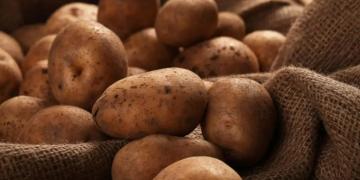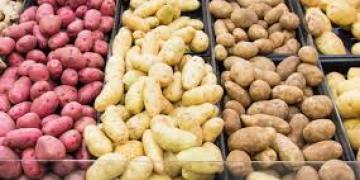Canada: Making potatoes friendly to soil health
Potatoes are a high-value crop and one of the world’s most important dietary staples.

But when it comes to sustainability, they’ve got a hurdle to clear because there’s no escaping some level of soil disturbance when growing and harvesting.
Why it matters: Soil health and minimized soil disturbance are major pillars in the push toward sustainable agriculture. That’s an issue for an underground crop.
That doesn’t mean the relationship between soil health and the potato sector can’t improve, according to Cam Ogilvie of the Institute for Soil Health.
“I’m part of an institution that’s based on science, so what I want to share with you is some real data-driven ways that we are thinking about soil health and particularly what that means in potato systems,” he said, speaking to potato growers at an industry event in Brandon in early 2024.
Soil is the medium in which dead tissue is absorbed, recycled and rejuvenated into living tissue. In poetic terms, it’s the shop floor of nature’s factory.
“Soil health is the continuous capacity of a soil to function, being able to do the things that we depend on it to do,” Ogilvie said. “I like to think about five different types of soil functions.”
First, soils cycle water and nutrients, two major raw materials required on that metaphorical factory floor. Secondly, soil contains a complex ecosystem that helps regulate pests and diseases. Certain organisms within the soil are themselves pathogenic to crop-damaging pathogens.
Third, structure and stability creates pore spaces within the soil profile that contain air and water. Fourth, those spaces provide habitat in which different and diverse organisms live and work and fifth, all those components filter and buffer pollutants, breaking down and detoxifying them.
Those functions work together to create a living medium on which plants depend, Ogilvie said. Understanding how they work is key to developing better ways to manage soil, so their performance must be quantified.
“We went to 124 long-term experimental sites in Canada, the U.S. and Mexico that compared soil management practices over 10 years or more,” he said. “We collected soils, ran over 30 different tests on them so we could figure out which ones are effective across North America.”
Using that data, the institute focused on three metrics that it has applied to soil sampling efforts.
The big three
The first test measures carbon mineralization potential, or the amount of carbon dioxide given off by soil organisms as they eat, digest and decompose organic material like roots and other tissue. Results indicate the size and activity of the microbial community in a given soil sample.
The second test is aggregate stability. According to Kelsey Greub of the University of Arkansas, this is “the ability of a soil to maintain its physical structure and withstand external forces.
“It’s related to physical, chemical and biological soil properties, and is sensitive to changes in soil management.”
The third measurement is soil organic carbon.
“A lot of us are familiar with soil organic matter and this is just the carbon fraction of it,” Ogilvie said. “Organic matter is made up of carbon, nitrogen, all sorts of other things. With soil organic carbon, we’re just looking at the carbon portion, which is roughly 50 percent.”
Using the factory metaphor, the three tests are equivalent to measuring the labour output, structural integrity of the building and fuel stores. The better the quality of all three, the better the work and product.
And, like a factory, quality of management will affect those measures. Ogilvie indicated four basic management principles to keep the metaphorical factory running well.
“We want to minimize soil disturbance such as tillage or chemicals. We want to maximize soil cover. We want to maximize the amount of living roots in the soil and we want to maximize biodiversity.”
A natural grassland, for example, ticks all those boxes, something often noted by Canada’s cattle sector.
In potatoes, limited soil disturbance is a challenge, but not a lost cause, said Ogilvie.
“There are some different ways that you can do this. You can completely remove a tillage pass or you can take two tillage operations and you can move them into one. Some people are starting to direct-plant their potatoes rather than making hills and planting as a separate one. That reduces erosion.”
Manitoba farms are among those trying new minimal soil disturbance strategies.
In 2020, Chad Berry of Under the Hill Farms near Glenboro hosted a demonstration trial of his own reduced-tillage efforts. In co-operation with J.R. Simplot, he looked to put yield impact numbers to his direct-seeded potato acres.
On the same field, acres were divided so that half were conventionally managed and half were direct planted into canola stubble using a one-pass hilling system brought to Manitoba with help from genAg.
Results showed no significant yield or quality difference between the conventional and direct-seeded acres. There was a slight emergence delay on the direct-seeded half, but stands caught up to their conventional counterparts during the season, and no difference in harvest date was noted.
“It definitely helped with soil erosion,” Berry told the Co-operator in 2021 after the project wrapped up. “It prevented any blowing.”
Berry also noted fuel savings.
Cover crops are another soil health tactic in potatoes, designed to keep residue in the field to feed soil biota and maintain living roots for as long as possible.
Last fall, the Manitoba Forage and Grassland Association’s annual regenerative agriculture conference highlighted regenerative potato production. The main speaker, Brendon Rockey of Rockey Colorado Farm in the U.S., particularly noted his use of cover crops.
For him, the main goal was better water infiltration and holding capacity, but versions of cover crops using mustard have also garnered attention for biofumigation against pathogens like verticillium wilt.
“When we integrate cover crops into our cropping systems, we increase the size and activity of the microbial community,” Ogilvie said. “We improve soil structure and we sequester more carbon in that soil.”
Some farmers in Alberta have combined fall hilling with cover crops. Freeze/thaw cycles help mellow the soil structure in the hill, while the greater surface area of the hill allows soil to warm up quicker in spring Ogilvie said.
“An extra benefit that comes is that you can get some roots in that hill.”
There are cautions, however. Producers concerned about water availability might want to skip cover crops that overwinter so they don’t take up water that could otherwise go to the potato crop.
Switching focus
There is still a lot to learn. Chemical soil traits have typically reigned supreme in agriculture, Ogilvie notes, and only recently has soil biology started to earn more attention.
“For me, this is what I think about when I use the word ‘regenerative,’” Ogilvie said. “If you’re improving how your soil is functioning, if you are improving the services that your soil provides by using soil conservation practices, that to me is what regenerative is all about.”
Fuente: https://www.manitobacooperator.ca/crops/making-potatoes-friendly-to-soil-health/




